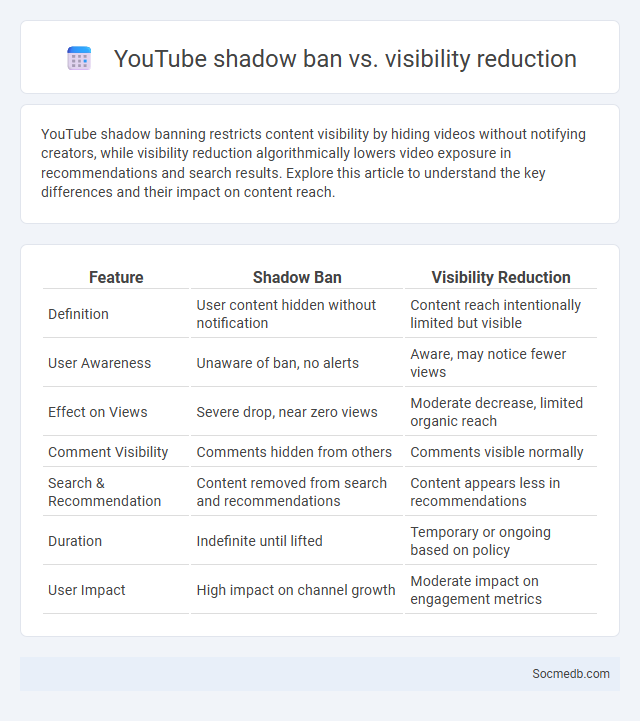
Photo illustration: YouTube shadow ban vs visibility reduction
YouTube shadow banning restricts content visibility by hiding videos without notifying creators, while visibility reduction algorithmically lowers video exposure in recommendations and search results. Explore this article to understand the key differences and their impact on content reach.
Table of Comparison
| Feature | Shadow Ban | Visibility Reduction |
|---|---|---|
| Definition | User content hidden without notification | Content reach intentionally limited but visible |
| User Awareness | Unaware of ban, no alerts | Aware, may notice fewer views |
| Effect on Views | Severe drop, near zero views | Moderate decrease, limited organic reach |
| Comment Visibility | Comments hidden from others | Comments visible normally |
| Search & Recommendation | Content removed from search and recommendations | Content appears less in recommendations |
| Duration | Indefinite until lifted | Temporary or ongoing based on policy |
| User Impact | High impact on channel growth | Moderate impact on engagement metrics |
Understanding YouTube’s Content Moderation Terms
YouTube's content moderation terms are designed to maintain a safe and respectful platform by enforcing community guidelines that prohibit hate speech, harassment, misinformation, and harmful content. These terms include detailed policies on copyright infringement, spam, and deceptive practices to protect both creators and viewers. Understanding these rules helps users avoid penalties such as video removal, account suspension, or demonetization, ensuring a positive experience on the platform.
What Is a YouTube Shadow Ban?
A YouTube shadow ban occurs when Your content is secretly restricted or hidden from appearing in search results, recommendations, or subscriber feeds without explicit notification. This covert limitation reduces visibility and engagement, making it harder for Your videos to reach a broader audience. Understanding shadow bans helps creators adjust their content and strategies to comply with YouTube's guidelines and avoid penalties.
How Visibility Reduction Differs from Shadow Banning
Visibility reduction limits the reach of a user's content by decreasing its appearance in feeds and search results without notifying the user. Shadow banning goes further by making a user's posts invisible or nearly invisible to the wider audience while still allowing the user to post normally, often with no clear explanation. Both practices aim to moderate content but differ in transparency and the extent to which user posts are suppressed on platforms like Twitter, Instagram, and TikTok.
Signs You’re Experiencing a Shadow Ban on YouTube
A sudden drop in video views, likes, and comments without changes in content or posting schedule often signals a YouTube shadow ban. Limited visibility on search results, suggested videos, and subscriber feeds typically indicates restricted reach due to algorithmic suppression. Monitoring analytics for consistent engagement declines, paired with absence of notification from YouTube, confirms potential shadow banning.
Common Reasons for Shadow Banning on YouTube
Shadow banning on YouTube often occurs due to violations of community guidelines, including posting content that contains hate speech, misinformation, or copyright infringement. The platform's automated systems and manual reviews target spammy behavior, misleading metadata, and repeated policy breaches. User complaints and engagement patterns that suggest inauthentic activity can also trigger restrictions, limiting video visibility without direct notification.
Visibility Reduction: Algorithmic vs. Manual Actions
Visibility reduction on social media occurs through algorithmic filtering and manual actions taken by platform moderators. Algorithmic actions use machine learning models to detect and limit content based on engagement patterns, keywords, and user behavior, while manual actions involve human review for policy violations like hate speech or misinformation. Understanding the differences between these methods helps users better navigate content visibility and compliance with platform guidelines.
Impact of Shadow Banning on Channel Growth
Shadow banning significantly limits a channel's visibility by restricting content exposure without notifying the creator, leading to decreased engagement and follower growth. Algorithms often suppress shadow banned accounts in search results, trends, and hashtags, directly impacting organic reach and audience expansion. This covert censorship hinders brand partnerships and monetization opportunities, stalling the overall growth trajectory of social media channels.
How to Identify Visibility Reduction on Your Videos
Visibility reduction on your videos can be identified by monitoring sudden drops in reach, engagement rates, and view counts across platforms like Instagram, YouTube, or TikTok. Pay close attention to notifications indicating algorithmic penalties or content restrictions, while also comparing performance metrics before and after posting. Tracking these signals helps you quickly detect and address any reductions impacting your video's visibility.
Preventing and Addressing YouTube Shadow Bans
Understanding YouTube's content guidelines and algorithmic criteria is essential for preventing shadow bans, which limit video visibility without notification. Consistently producing original, community-compliant content while avoiding spammy behavior or copyright infringement helps maintain channel integrity. If shadow banned, creators can address the issue by reviewing analytics for sudden drops in views, appealing through YouTube support, and engaging authentically with their audience to rebuild reach.
Transparency and Controversy in YouTube Moderation
YouTube's moderation policies emphasize transparency to build trust between the platform and its users, clearly outlining content guidelines and enforcement procedures. Controversy often arises when YouTube's algorithms or human moderators inconsistently apply rules, leading to debates over censorship and freedom of expression. Your engagement with YouTube's content can be affected by these moderation practices, which continuously evolve to balance community safety and open dialogue.
 socmedb.com
socmedb.com